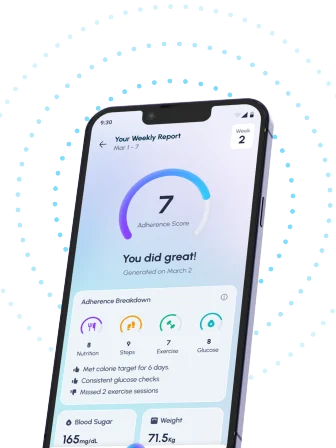Prediabetes is a wake-up call. It means your blood sugar levels are higher than normal but not yet high enough to be classified as type 2 diabetes. But how many people with prediabetes actually progress to diabetes? Understanding the risks and prevention strategies can help you take control of your health before it’s too late.
What is Prediabetes?
Prediabetes is a condition where blood sugar levels are elevated but not high enough for a diabetes diagnosis. It is a warning sign that your body is developing insulin resistance or struggling to manage blood sugar effectively.
Criteria for Prediabetes
According to the American Diabetes Association (ADA), prediabetes is diagnosed when:
- Fasting Blood Sugar: 100–125 mg/dL
- Hemoglobin A1C (HbA1c): 5.7%–6.4%
- Oral Glucose Tolerance Test (OGTT): 140–199 mg/dL (after two hours of consuming glucose)
What Percentage of People with Prediabetes Develop Diabetes?
Studies suggest that 15%–30% of people with prediabetes will develop type 2 diabetes within five years if they don’t take preventive measures (CDC, 2023). Over a longer period, the risk increases significantly. If lifestyle changes are not made, up to 70% of individuals with prediabetes will eventually develop diabetes.
Factors That Increase the Risk of Progression
Certain factors accelerate the progression of prediabetes to diabetes:
- Genetics: Family history of diabetes raises the risk.
- Obesity: Excess body fat, especially around the abdomen, increases insulin resistance.
- Sedentary Lifestyle: Lack of physical activity contributes to poor blood sugar control.
- Unhealthy Diet: High sugar, processed food, and low-fiber diets worsen insulin resistance.
- Age: People over 45 are more prone to diabetes.
- Polycystic Ovary Syndrome (PCOS): Women with PCOS have higher diabetes risk.
- High Blood Pressure & Cholesterol: These conditions are linked to metabolic disorders and insulin resistance.
Can Prediabetes Be Reversed?
Yes, prediabetes can be reversed with lifestyle changes. Studies show that losing 5%–7% of body weight and engaging in 150 minutes of moderate exercise per week can reduce the risk of developing diabetes by 58% (Diabetes Prevention Program, NIH).
Key Strategies to Prevent Diabetes
1. Adopt a Healthy Diet
- Increase fiber intake (vegetables, whole grains, legumes)
- Reduce processed sugar and refined carbs
- Choose lean proteins (chicken, fish, tofu)
- Stay hydrated and avoid sugary drinks
2. Exercise Regularly
- Engage in at least 30 minutes of exercise five days a week
- Include strength training to improve insulin sensitivity
- Walking, cycling, and swimming are great choices
3. Maintain a Healthy Weight
- Losing even 5% of body weight can significantly lower risk
- Focus on gradual, sustainable weight loss
4. Monitor Blood Sugar Levels
- Regular blood tests help track progress
- Work with your doctor to adjust your lifestyle accordingly
5. Manage Stress & Sleep
- Poor sleep and chronic stress increase insulin resistance
- Aim for 7–9 hours of quality sleep per night
- Practice mindfulness, meditation, or yoga
Why Some People with Prediabetes Don’t Develop Diabetes
Not everyone with prediabetes progresses to diabetes. Some people naturally have better insulin sensitivity, and those who actively manage their diet, exercise, and lifestyle significantly reduce their risk.
Natural Protective Factors
- Strong metabolism & genetics
- Early intervention with lifestyle changes
- Regular physical activity & muscle mass maintenance
What Happens If Prediabetes Turns into Diabetes?
If prediabetes is left untreated, it can lead to full-blown type 2 diabetes. This can cause complications such as:
- Heart disease and stroke
- Kidney disease
- Nerve damage (neuropathy)
- Eye problems and vision loss
- Foot complications and amputations
FAQs on Prediabetes and Diabetes Progression
1. Can prediabetes go away completely?
Yes, with proper lifestyle changes, prediabetes can be reversed.
2. How often should I check my blood sugar if I have prediabetes?
At least once every three to six months, or as recommended by your doctor.
3. Is medication necessary for prediabetes?
Not always. Most people can manage it with diet and exercise, but in some cases, doctors prescribe Metformin to reduce the risk of diabetes.
4. What is the best diet for reversing prediabetes?
A Mediterranean diet rich in vegetables, whole grains, lean proteins, and healthy fats is ideal.
5. Can stress cause prediabetes to turn into diabetes?
Yes, chronic stress increases cortisol, which affects insulin regulation and blood sugar levels.
Conclusion
Prediabetes is a warning sign but not a life sentence. If left unchecked, up to 70% of people with prediabetes will develop diabetes. However, by making small but consistent lifestyle changes—eating healthier, exercising, maintaining a healthy weight, and managing stress—you can prevent or even reverse prediabetes. Take action today to protect your future health.



